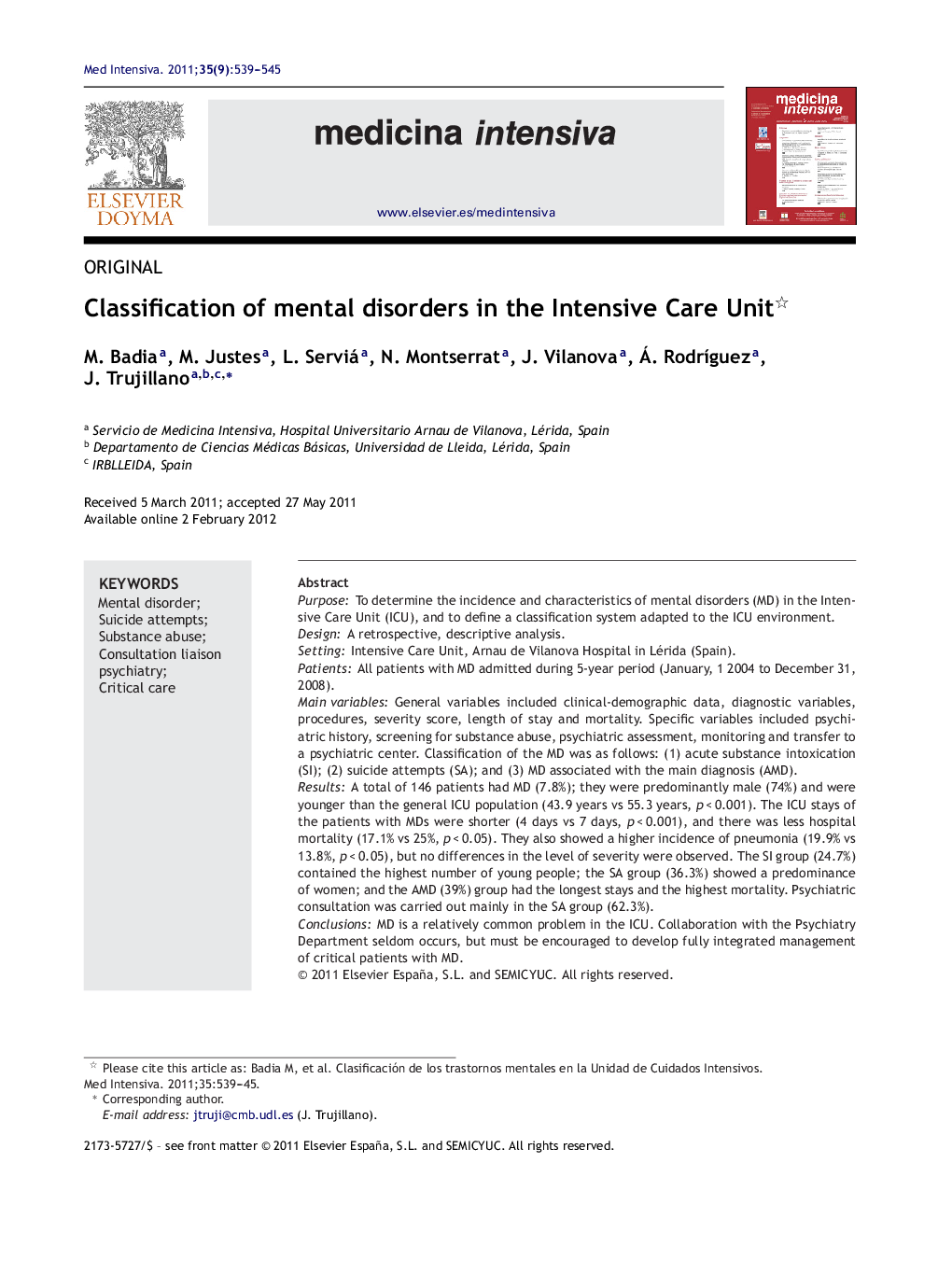| Article ID | Journal | Published Year | Pages | File Type |
|---|---|---|---|---|
| 3114301 | Medicina Intensiva (English Edition) | 2011 | 7 Pages |
PurposeTo determine the incidence and characteristics of mental disorders (MD) in the Intensive Care Unit (ICU), and to define a classification system adapted to the ICU environment.DesignA retrospective, descriptive analysis.SettingIntensive Care Unit, Arnau de Vilanova Hospital in Lérida (Spain).PatientsAll patients with MD admitted during 5-year period (January, 1 2004 to December 31, 2008).Main variablesGeneral variables included clinical-demographic data, diagnostic variables, procedures, severity score, length of stay and mortality. Specific variables included psychiatric history, screening for substance abuse, psychiatric assessment, monitoring and transfer to a psychiatric center. Classification of the MD was as follows: (1) acute substance intoxication (SI); (2) suicide attempts (SA); and (3) MD associated with the main diagnosis (AMD).ResultsA total of 146 patients had MD (7.8%); they were predominantly male (74%) and were younger than the general ICU population (43.9 years vs 55.3 years, p < 0.001). The ICU stays of the patients with MDs were shorter (4 days vs 7 days, p < 0.001), and there was less hospital mortality (17.1% vs 25%, p < 0.05). They also showed a higher incidence of pneumonia (19.9% vs 13.8%, p < 0.05), but no differences in the level of severity were observed. The SI group (24.7%) contained the highest number of young people; the SA group (36.3%) showed a predominance of women; and the AMD (39%) group had the longest stays and the highest mortality. Psychiatric consultation was carried out mainly in the SA group (62.3%).ConclusionsMD is a relatively common problem in the ICU. Collaboration with the Psychiatry Department seldom occurs, but must be encouraged to develop fully integrated management of critical patients with MD.
ResumenObjetivoConocer la incidencia y características del trastorno mental (TM) en la UCI y definir una clasificación adaptada al entorno de UCI.DiseñoEstudio descriptivo y retrospectivo.ÁmbitoUnidad de Cuidados Intensivos polivalente del Hospital Universitario Arnau de Vilanova de Lérida.PacientesSe incluyó 146 pacientes que ingresaron con TM durante un periodo de 5 años (1 de enero de 2004 a 31 de diciembre de 2008).Variables de interésVariables generales: clínico-demográficas, diagnóstico, procedimientos, gravedad, estancia y mortalidad. Variables específicas: antecedentes psiquiátricos, screening de tóxicos, valoración psiquiátrica, seguimiento y traslado a centro psiquiátrico. Clasificación del TM: 1) intoxicación aguda por sustancias (IS), 2) intento autolítico (IA) y 3) trastorno mental asociado al diagnóstico principal (TA).ResultadosUn total de 146 pacientes con TM (7,8%). Predominio de varones (74%) y más jóvenes (43,9 vs. 55,3 años, p < 0,001). La estancia en la UCI fue más corta (4 días vs. 7 días, p < 0,001) y hubo menor mortalidad hospitalaria (17,1 vs. 25%, p < 0,05). Sin diferencias en nivel de gravedad pero más incidencia de neumonía (19,9 vs. 13,8%, p < 0,05). El grupo IS (24,7%), más jóvenes, el grupo IA (36,3%) con predominio de mujeres y TA (39%) con estancia y mortalidad más altas. La consulta a Psiquiatría se realizó prioritariamente en IA (62,3%).ConclusionesEl TM es un problema relativamente frecuente en UCI. La colaboración con Psiquiatría es minoritaria y debe ser potenciada para conseguir un manejo integral del paciente crítico con TM.
